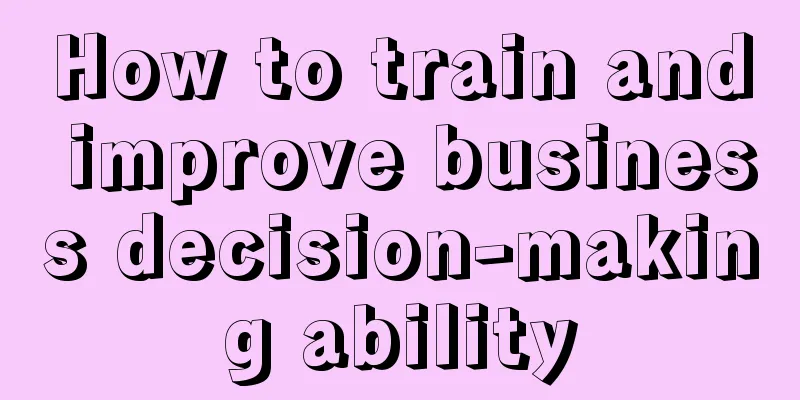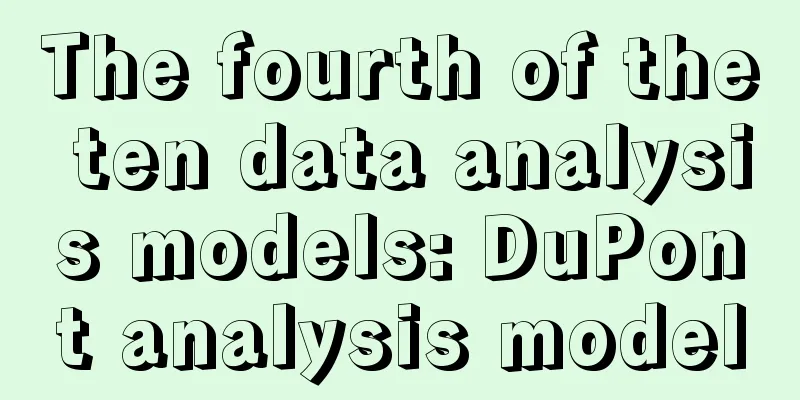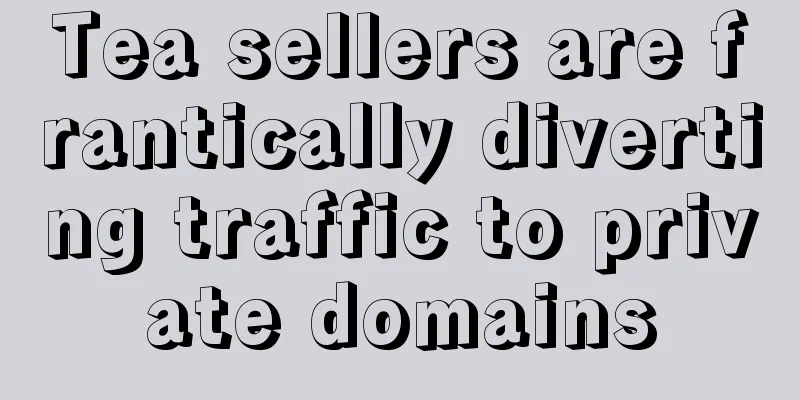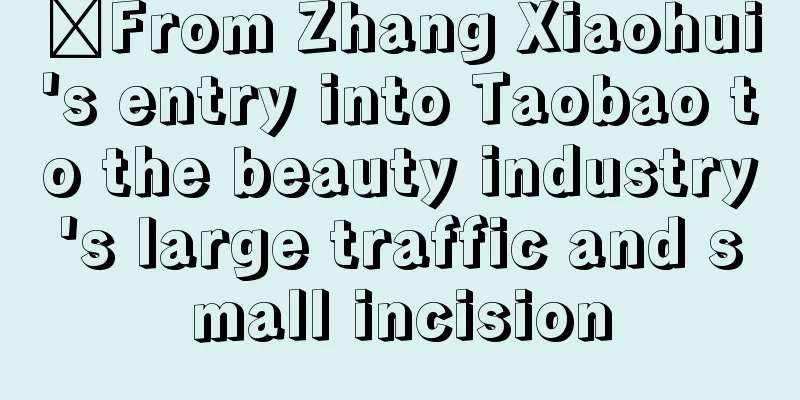How to train and improve business decision-making ability

Recently, a friend who works in growth asked me whether the pricing of a product is something he should consider. How do you answer this question? I don’t know whether friends who work on growth have considered this issue in the past decade. But they will definitely have to consider this issue in the next decade. In short, if you are not clear about something, there will always be a higher-level leader who knows it. Products and operations have become more and more integrated, and it is the best choice not to draw boundaries for yourself. In the next ten years, without a large number of user growth, companies need efficiency to survive. Management will become the talent requirement for future companies, and the business environment will require that only companies that provide the best service to users and have low operating costs can survive. Whether it is the market, products, operations or data, you must care about the business. It is a necessary ability to look at the company from an operational perspective. But what is management? I read a lot of information on my own and found that the word management was first proposed by Japan, so everyone would read Japanese management knowledge, and most of the books on the market are translations of Japanese management concepts. It’s not that there’s something wrong with Japan’s business philosophy, but it’s clear that it can’t adapt to the Internet. It’s more like a real economy strategy. Therefore, I combined my own business philosophy and explained management from the perspective of decision-making. I hope that readers will first understand management from the perspective of decision-making. This ability is closely related to all non-technical Internet people and everyone uses it every day. 1. What is business decision making?Business decisions are business actions taken around business objectives in order to achieve those objectives. 1.1 Description of business decisionsLet us explain in detail here. First of all, the business objectives are the business goals that need to be achieved year by year when the direction of the enterprise is determined. It is directly or indirectly related to revenue, such as GMV, operating income, and net income. The second point is business operations. In fact, as Internet people, all our business takes place online, whether it is products, operations, marketing, or media channels. Our daily work is all business operations. You can roughly understand business actions as every action you take in your position is a business action. The implicit assumptions behind this are: Everything you do has an "opportunity cost". If you do this thing, you will give up something else, or you can do something else later. 1.2 Scope of business decisionsHow to make decisions is actually a very complex question, because the granularity of decision-making can be very large or very small. When talking about corporate strategy, we often say that strategy is to find a way to survive. Strategy is based on the directional choice of goals. What to choose and what not to choose is a decision-making problem. Let's take a demand review as an example. Choosing what to do and what not to do is still a decision-making problem, so decision-making is about making choices. The complexity and size of the decision make completely different decisions about what needs to be considered. So let’s first talk about how to make medium- and short-term decisions, which are more inclined to operational decisions, while decisions that affect the long term are more inclined to strategic decisions. 2. How to make high-quality decisionsSince we are talking about short-term and medium-term decisions, let's first talk about what medium-term and short-term decisions are. There is a book called "You Can't Learn to Do Haidilao". Why you can't learn to do Haidilao? It's not that the service level of the service staff is difficult to learn. In fact, you can send undercover agents or observe Haidilao's service employees for a long time and imitate them. But this service is not sustainable... The reason lies in Haidilao's high-quality service. Behind it is a series of business operations that ensure that the employees' service is very good. Let's talk about it briefly. First, Haidilao has its own employee incentive system. Employees can work their way up from being waiters to store managers, and then grow into store managers of several stores. Second, Haidilao also has a set of coaching system training during this process. When you become a coach, you can open a new store every time you train a store manager. Finally, Haidilao has its own mysterious scoring judge system to score the service of each store. We can see that Haidilao has actually done a lot of business operations behind the service to ensure the quality of its service. It has interest traction, a training system, and action monitoring. These business systems are the reason why Haidilao can provide high-quality services compared to its competitors. These systems cannot be completed overnight; they require long-term iterations and are more inclined towards short-term and long-term business decisions. The example of Haidilao is to illustrate what is a short-term decision and what is a long-term decision. Usually, decisions that are biased towards the long term will make the company more competitive in the future and have more freedom to make short-term business decisions. When we see a competitor making a business decision that we cannot copy, we should think more about why. Why can the competitor do it but I can’t? This why is biased towards long-term business decisions. Mid- to long-term business decisions determine whether you can make unique business moves when competing with your competitors, such as meticulous service, higher efficiency, lower costs, lower prices, etc. Only long-term business decisions can allow short-term decisions to accumulate and thus form their own business barriers: Business barriers must be related to time accumulation. Your competitors need a similar amount of time to reach your current state. He must do it in the same amount of time, not with the same resources, and long-term business decisions must not be something that can be accelerated by competitors piling up resources. Haidilao's management of employees and stores are short-term business decisions, including service processes, service words, service details, etc. These are short-term business decisions that can be quickly iterated and modified. We can also think in terms of business objectives. The decisions and business actions made for the business objectives of the year are basically short-term. 2.1 Decision making from the perspective of business impact2.1.1 Short-term demand vs. short- to medium-term demand First, we determine whether to implement this business strategy based on the business type, that is, whether it is a short-term strategy or a long-term strategy. Usually long-term strategies will be reflected in the following aspects of business: 1) Either the cost of investment is reduced once and for all; 2) Either the investment brings about an improvement in effects such as branding; 3) Either you reduce the cost of repeated actions. For example, you have to do the same operation activities every month, such as lucky draws and profit sharing. Now I make a template, and the cost of research and development is saved from then on; 4) Either you are solving a dilemma. Sometimes, it is a dilemma where user A is satisfied but user B is not satisfied. How to distinguish between A and B is a dilemma. 5) Another way is to solve the dilemma of balancing costs and benefits. When I expand my scale, although my income increases, my costs also increase rapidly. These are the core capabilities we need to build, and they are also the points we need to consider for our short-term or long-term needs. Usually, on this basis, we still need to consider dimensions such as business conditions and external environment. If we only consider the long-term benefits to the company's development, then we should do any business actions that can create barriers in the long run. In fact, most companies have a certain resource inclination, allowing capacity building and short-term business operations to have an operating ratio of investment. If they do not invest in long-term capacity building, they will die, and if they invest too much in long-term construction, they will die. Therefore, after analyzing the business problems or requirements raised by the business party, we should first analyze whether it is a short-term or long-term strategy. The easier distinction here is that the characteristics of the strategy itself can determine whether it is short-term or medium-term. What is more difficult is that some short-term strategies may imply a long-term strategy stage. For example, if I have carried out several operational activities in succession, R&D needs to be redeveloped each time, and testing needs to be done each time. At this time, if I put forward the iterative requirements of an operational activity, it may be a better decision to consider building a medium- and short-term tool platform such as an operational tool. Another more difficult situation is that a short-term strategy is included in the medium- and short-term strategy. He can both build barriers and partially solve current business problems. For example, the delivery system can be divided into delivery configuration, delivery reporting, data collection, visual delivery dashboard and other links. This is a project to see the efficiency of delivery and customer acquisition in the long term, but we can split it into multiple decision-making actions. For example, we should first make delivery configuration, which is the basis of all data sources. Therefore, no matter whether we are thinking about business operations ourselves or the business operations given by the business party, we must think about whether the impact of this action on the business will be beneficial to this year's performance in the short term or have a long-term impact. If it is a long-term business operation, it is not as simple as the business party proposing a demand and the product operation writing a requirement document. It may be necessary to convene multiple parties for communication, demonstrate value, plan projects and development milestones, etc. before a medium- or short-term project can be launched. These tasks are usually led by products or product operations, and they are usually more likely to think about the company's product system in a systematic way. So when you get a demand, you first need to rule out whether it is a demand that seems short-term but is actually long-term at the system level, or a demand that seems long-term but can actually be broken down into short-term ones. Their response methods are completely different. 2.1.2 Directly Impacting Business VS Supporting Business The second dimension of thinking is business operations. Usually there are three types of business actions: the first is direct intervention, the second is internal support business, and the third is the "clear view" of business operations. Usually, the annual operating goals are short-term and generally support business-oriented, such as daily product iterations, optimizing registration channels, and opening new payment methods. These are all business-oriented and such needs can usually be completed in one to several weeks. They have a direct impact on the business. Generally speaking, operational actions that affect the business have a higher priority than business support actions. At the same time, when making decisions, we will also break them down and quantify them. The latter two categories have indirect effects on the business. For business support actions, such as contract review, the review cycle is relatively long, which has affected the speed of your customer signing. Then the support demand has seriously affected the business. Then the priority will naturally become higher. When facing medium-term or long-term goals, the value of strategies that directly intervene in the business and strategies that support the business need to be evaluated specifically based on the business situation. There is another type of business decision that is easily confused. Those decisions appear to support business needs but in essence directly interfere with the business. All businesses will be operated by someone, such as organizational structure adjustment, business process adjustment, and customer service division of labor adjustment. If the software system is not iterated accordingly, it will not be able to support the organization, and in fact, it will not be able to support the business. These decisions are essentially decisions that directly affect business operations, but the users you face are internal company employees. 2.1.3 Development Required vs. No Development Required First, we need to determine the priority of decisions from the perspective of long-term, short-term and business. Long-term needs can be divided into short-term needs, or short-term needs are actually part of the underlying long-term needs to support operations. We need to conduct a more careful review. In addition, if the needs or decisions are divided into multiple small needs, we can determine whether it can be implemented without development. If a requirement can be supported by the current system or non-software system, it is preferred not to develop it and operate it manually. This is especially suitable for teams with heavy offline business or teams with physical delivery. It is not applicable to games, tools, such as search, AR, VR, IM, etc., or enterprise SaaS software systems. Of course, these systems can also be split into multiple small subsystems to reduce experimental costs. For example, the education company I worked for before developed a teaching system. In fact, it didn’t need to develop it right away. It could let its own courses and students operate it for a period of time. During this period, various problems would be exposed, and the differences between the product and operation ideas and the actual operation. Operating it for a period of time before developing it would avoid many problems and verify the actual value of the business. 2.2 Decision-making from the perspective of user valueLooking at problems from the perspective of user value is usually the most common perspective for positions such as product and operations. The core is to look at: 1) Are the business actions or decisions made useful to users? 2) If it is useful, how useful is it? One is a qualitative perspective, and the other is a quantitative perspective. Let’s talk about the qualitative perspective first and look at decisions from the perspective of user value. 2.2.1 Whether to strengthen the core value of the product The core of a product is to meet a certain core demand, and based on this demand, it continuously expands new segments of the population, segments of the field, and segments of functions. Therefore, the core functions that a product meets are actually the most competitive and vital. This means that at this stage, the current technology implementation or supply can already meet the needs of most people. Let's take a few examples: The core function of Amap is navigation. Based on this function, more and more people are using it, and the market has begun to segment the market, such as local life, refueling, hotel reservations, real-time public transportation, etc. The needs that have been differentiated are more about meeting the needs of segmented groups and scenarios. Here is another example: The core function of Meituan Takeaway is to deliver the food made by the restaurant to a place. But is it only meals or restaurants that can deliver an item to the place specified by the user? In fact, this is not the case. For example, medicines, fresh vegetables, office documents, etc. all have this scenario. Then Meituan created another express delivery business. Even considering the time scenario, there will be an ultra-fast delivery within 1 hour. In fact, the demand intensity of users for food to be delivered to a certain location is the greatest, and the number of people is also the largest. When we make business decisions, whether it is operations or products, we need to consider whether your decision is close to the core needs of your business or operations. For example, if we are doing food delivery business, better estimating the arrival time and the peak meal ordering is better than providing a new medicine delivery function, because the former strengthens our core function and core user value. For example, for a physical product oven, if you add a function in which the user can select a reminder music when a timer arrives, then you don’t say that adding a steam baking function is closer to the core function. Just now we delivered an item to a certain place, or delivered a product to a certain place within a certain time. This involves the second question, which is to look at the decision from the perspective of the business model. 2.2.2 Whether to change the business model Let’s take the example of food delivery. If we add more takeout restaurants to the platform, do better dispatching, better delivery estimates, and better after-sales experience, will these change our business model? In fact, no, we are iterating on the business chain. We have not changed our business model. To make this complex judgment, the business process and model are still the same, but I have added new segmentation channels. For example, I have never used ground promotion before, or I have added user recommendation methods to acquire users, or I have promoted to users who have not been reached before. For example, I was previously focusing on first- and second-tier cities, but now I am moving down to third- and fourth-tier cities. This is an adjustment to the business, which is not easy to balance, but it still does not change the business chain. For example, the users I just mentioned are still the same group of users. I added more consumption scenarios, such as introducing more types of goods into e-commerce. For example, I started selling women's sportswear instead of women's fashion. Or I started delivering food to Shansong users instead of food delivery. These are all ways to modify business supply. These business decisions are more complex and require more consideration than directly iterating the user value of the business itself. For example, after the channel is established, the user's value perception and even after-sales service need to keep up. For example, if new supply is introduced, does it mean that procurement and business need to communicate with more suppliers? However, this is still not the most difficult problem in business decision-making. The most difficult business trade-off is to start a new business. It is partially coupled with your business. Let's take an example: For example, Didi's launch of private cars and premium models, is this a brand new business in decision-making analysis? Obviously not. When I take an online car-hailing vehicle myself, I find that some drivers have reduced their authority and are driving express cars. The express car I once took was a business 7-seater express car. Private cars and premium services are more like specifying better service quality standards in the supply, selecting high-quality service drivers from among them, and setting higher prices, so as to discover passengers who are willing to pay a higher price for good quality services from the user side. At this time, I added a screen in the car to play advertisements. Many students who took taxis in Beijing should have taken such online taxis. So at this time, is he still operating according to the original business process? Actually, not. At this time, his customers have become businesses that need to advertise. The customer acquisition channel has also become sales to attract advertisements, and the supply side has become passengers who watch advertisements. But if I view this screen merely as an entertainment tool for users to help them pass the time during their travels, then it becomes an operational decision to create more subdivided areas in the original business. Although it is just a screen added to the car, the positioning is different, so the business decisions are completely different. 2.2.3 Is it possible to quantify decisions and user value? When it is difficult to make a balance in making operational decisions to strengthen the core value of a product or change the business model, the most commonly used method is quantitative estimation or quantified demand. User value = user group size ✖️ usage frequency ✖️ demand intensity Therefore, when making decisions, you can estimate the population, such as the population of a certain channel, the population of a certain function, and roughly know how many people will be affected. The second is how many times users will use it and how many users will actually use this function. Having users with demand and having users use it after development are two different things. For large functions, I personally recommend conducting user interviews or accumulating user experience on a regular basis, and using small sample sizes to infer changes in large sample sizes. This is an estimation method. Secondly, for functional conversion, we can make inferences through the click distribution of the layout. This is also a method. Again, we can make inferences based on physical boundaries. For example, if your product is a food delivery product, users will usually only order 1 or 2 takeout orders a day, and at most they will order breakfast, not more. This is determined by the real world. For example, for shared bicycles, you usually ride it twice in a hot spot, once on your way to and from get off work, and then you can get a rough idea of how the function is used. In short, quantitative estimation is a very important method to weigh the priorities of multiple requirements. We can also quantify its impact on core business indicators and ultimately determine the priority. 2.3 From the perspective of transaction modelThe above mentioned the big business model. We can also make trade-offs for a certain function or operational strategy by looking at the transaction model. 2.3.1 Is the user's benefit consideration comprehensive? Lower prices Regarding user operations, we can provide users with various types of benefits. We prioritize whether this demand can bring in cash income, or whether it can lower the user's delivery cost. If it is lower, more users will use it. Save time The second is to help users save time, such as reminder functions, or shorten the dispatch time, optimize the scheduling algorithm, and reduce the user's usage time. This is also a demand that users are more aware of. Improved safety The second is the value of safety and personal safety. Many people think that the probability of safety accidents is not high, so many products do not consider the value of safety when they are thinking about them. In fact, safety is a major prerequisite for transactions to take place, such as the safety of financial products, travel safety, and even the food safety of a restaurant. The probability of it happening is not high, but once it happens, the damage rate will be very high. The value of safety = the probability of a safety incident occurring ✖️ the degree of safety breach The vast majority of safe business decisions will reduce the probability of safety incidents to a level that is acceptable to operations and costs. Of course, if costs are controllable, 100% elimination of safety incidents is the best option. Perceived Value Perceived, the user subjectively believes that it has value, but in fact it may not have value, for example, the function has value, but the user does not perceive it. We can give an example of perceived value. I don’t know if you have all been to Beijing Global, where there is a game project called "Lights, Photography, and Shooting". After entering, a video of Spielberg and Zhang Yimou is played first. This actually has two meanings. The first is to prepare you emotionally for the following program, and the second is to make the user's waiting less obvious. It is a transit link. The users in front are playing the project, and the users behind are queuing. In this way, once the previous game is over, these users can directly start the game in the atmosphere rendered by the video. The same design was also used in Universal's "Minions Fall Out", "Fire and Fire" and "Forbidden Journey". In addition to the normal queue, there is a long plot at the beginning of the game. The purpose is to make the queue less boring, let users enter the game state, and perceive the value. For example, some security algorithms behind the scenes may prevent many things from happening, which is valuable, but users are not aware of it because the security incident did not happen. It is also necessary to let users know, such as text messages, reports, or summaries. For example, the annual report of some software, because the value of daily use is not perceived by everyone. At this time, a report is given to you so that you can know the value of the APP. 2.3.2 Judging from the implementation cost When it comes to the cost of business decision-making needs, people usually consider development costs. In fact, in addition to development costs, there are many other dimensions to consider costs. The first is the cost of the hardware. For example, I need to store a lot of data. A friend once asked me why some hardware recording products don’t come with cloud storage. In fact, this is a trade-off issue, that is, the cost of the free storage space is less than the increase in sales profit of recording products brought about by the free storage. This is appropriate. The second is the cost of trial and error. For example, some requirements are not fault-tolerant. If I try a content review mechanism and there is a problem, the impact may be very large. At this time, it does not mean that this requirement has low priority. Some manual decisions may be needed to make a backup. The promotion and stability of this requirement has become the top priority. The third is opportunity cost. If I make a splash screen ad, users may be disgusted, but it will bring me profit. If I use the ad position to attract traffic to category A, I cannot attract traffic to category B. The fourth is maintenance cost. For example, the automatic IM reply may need to be constantly maintained as the business develops. It is not a one-time thing. I need to continue to iterate. 2.3.3 Judging from the decision model So let's summarize the overall method of business decision-making. When we receive a demand or have a lot of ideas about the business, we need to analyze step by step and make a final decision. The dimensions of thinking are as follows: 1. We need to first look at whether it is valuable to the business in the long term or in the short term. Long term value requires a more careful review to decide whether to invest resources to carry it out. 2. In the short term, you need to first determine whether to intervene in the business strategy or support the internal strategy. In terms of support, you can use the two decisions of user value and transaction model to see whether it will really affect the business, and then make a quantitative analysis of the impact to make a trade-off. 3. If it is to interfere with the business, then see whether development is necessary or it can be run in a non-software form first. If development is necessary, make further decisions. 3.1 First check whether the core value of the product is enhanced. If so, then check whether it will change the channel or supply, or change the business model as a whole. 3.2 Then do quantitative value analysis to quantitatively estimate the changes and decide which business actions to prioritize. 4. After determining the user value, look at the content of the user value itself: 4.1 Determine the value of this need in terms of money, time, safety, and perception. 4.2 After determining the demand itself, weigh the input and output from the cost of implementation. The only need to be considered separately is the safety demand, considering the cost of implementation and the probability of occurrence. Safety is a bottom-line demand and is different from business issues. 3. How to promote decision-making implementationNo matter how good a business strategy is, it has no value if it cannot be implemented. 3.1 Decision-making is close to the core directionThe company's resources are allocated from top to bottom, so our business actions are best aligned with the leadership's direction, so that it is easier to get resources. Most business strategies require resources. If they are aligned with the core direction, they will be higher in priority. 3.2 Decision-making should be based on stakeholdersYour business decision itself is the best way to promote the common interests of your partners. For example, as a product, it not only meets your product planning, but also empowers and improves the efficiency of the business department. Then it will be easy to promote. For example, if you are engaged in operations to attract new customers, and the other party is in production research and also has KPIs for attracting new customers, then the business operations will be easier to promote. On the contrary, if the other party has KPIs in other directions, it will be difficult for you to promote them. For another example, if you want to accumulate data and see the data clearly, but the other party has pressure from business KPIs, he will not be willing to invest in infrastructure. If there is no way to achieve mutual benefit, such as business or business to R&D, it is best to guide the other party to co-build or participate, such as early communication and program planning stage to introduce the other party to participate in advance. This will also make it easier to advance. 3.3 Decisions should be explained clearlyHow to ensure that the decision is not deviated, because there will definitely be many people asking that a decision was made, but R&D does not agree, saying that the cost is too high and needs to be cut, but the requirements are cut, and the solution is particularly weird. Operations and products feel that the upper limit of this solution cannot achieve the effect, what should I do? At this time, the most important thing is to return to the product manager himself. The responsibility of the product manager is to study the problem clearly and expose it fully. If you make a decision today, and this decision is logically rigorous and the facts are clear, then after you make this decision, R&D still does not agree, then there must be a certain link in it, and its importance has not been fully exposed for everyone to accept. You need to communicate these points that R&D does not agree with and expose the problem. If you find that the cost of the smallest MVP is still very high after breaking it down, it is likely that there is something wrong with your breakdown. If not. Let everyone know what the current minimum available range is. This is your bottom line. The bottom line is that if you compromise again, this thing will not achieve the expected effect after it goes online. First, let the R&D team understand this bottom line. After understanding the bottom line, if you still find that it is not recognized, then you can only find a way to study it clearly and fully expose it. If you still cannot reach an agreement at this time, then you can only evaluate whether there is a problem with organizational collaboration or your own way of thinking. Author: Arun's Growth Research Institute Source: WeChat public account "Arun's Growth Study Club" The article was originally published by @阿润’s Growth Research Society on Operation Party. Any reproduction without permission is prohibited. The title image is from Unsplash, based on the CCO protocol. |
<<: How to break through the "value for money" marketing that all brands are pursuing?
>>: Is “Moutai+” Moutai’s panacea?
Recommend
How does eBay operate? The core idea of eBay operation
Merchants who want to join the eBay platform need ...
From "brainwashing hits" to IPO: What did Mixue Bingcheng do right in its brand marketing?
From the viral spread of the "brainwashing di...
Is the quiet video account making money quietly or is no one making money?
Video accounts, which are known as "Buddhist ...
The secret of e-commerce experts to make money: follow the trend
"The way to make money in e-commerce is to fo...
The guild’s operating philosophy has changed: anchors are selected from “one in a hundred”, there is no PK, and brushing turnover has become history?
Under the new anchor model, what happened to the g...
Does Amazon DHL need to do customs clearance by itself? What is customs clearance?
Amazon's overseas shopping platform is very po...
How to cancel the pre-sale system?
During this year's 618 shopping festival, all ...
How to calculate the conversion rate of an independent website? What does the conversion rate of an independent website mean?
There are actually quite a lot of merchants who wa...
Blind box live streaming: Why do young people pay for it?
Blind box live broadcasts have emerged on platform...
What are the Wish distribution tips? What should I pay attention to?
Today, I will introduce you to the content of open...
Does Shopee need to pay taxes for cross-border e-commerce?
We know that Shopee has a relatively low entry thr...
Does Shopify require rent? What are the Shopify transaction fees?
Cross-border e-commerce on Shopify adopts the mode...
Weibo AI is "far ahead" in terms of venomous tongue in the comment section
Explore how the Weibo AI robot "Comment Rober...
What is a normal conversion rate for new products on Amazon? What are the requirements?
After the cross-border e-commerce Amazon launched ...
To bosses: Your product is great, but why don’t users buy it?
Stimulating consumers' pain points has always ...









